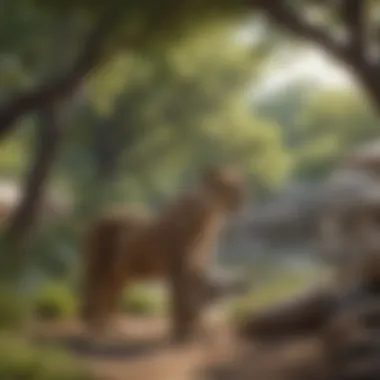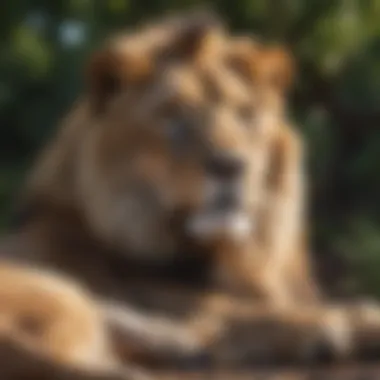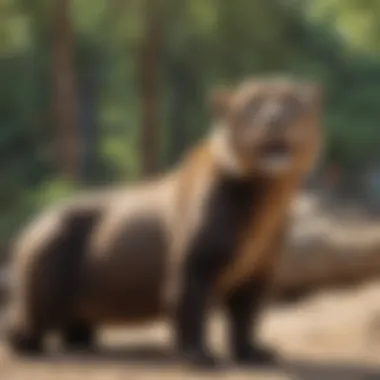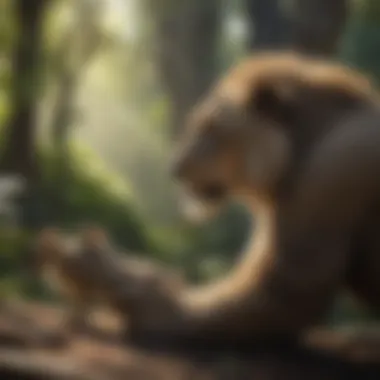Discovering America's Largest Zoos: A Comprehensive Look


Intro
America's largest zoos serve as more than just recreational spaces; they stand as crucial pillars in wildlife education and conservation. These institutions bring together a diverse collection of animals, offering visitors a glimpse into ecosystems that they may never encounter elsewhere. The scale and variety of these zoos underscore the significant role they play in not only housing animals but also in educating the public about wildlife issues. This guide aims to navigate through various aspects of these zoos, examining their vast animal collections, conservation initiatives, and the educational programs they offer.
Fascinating Facts About the Animal
Understanding the unique characteristics of animals housed in zoos enriches the visitor experience. Each species displays distinct traits that contribute to their survival in the wild. Here, we delve deeper into these fascinating features that captivate audiences and educate them about biodiversity.
Unique Characteristics
Many animals featured in America's largest zoos exhibit remarkable physiological and behavioral adaptations. For example, the Giraffe has an elongated neck that allows it to access leaves high in trees. This adaptation not only aids in feeding but also serves as a means of social signaling among other giraffes. Another example is the Snow Leopard, whose thick fur and long tail enable it to thrive in cold mountainous regions. These unique features spark curiosity and highlight the importance of species preservation.
Extraordinary Abilities
Certain animals possess extraordinary abilities that both fascinate and educate. The Octopus, known for its intelligence, exhibits problem-solving skills and can camouflage itself remarkably. This capability intrigues both visitors and researchers, opening discussions about the cognitive abilities of non-mammalian species.
Behavior and Habitat
The way animals interact with their environment and each other can reveal much about their species and promote educational discussions among visitors.
Natural Habitats
Zoos attempt to recreate natural habitats as closely as possible, which benefits both animals and visitors. The California Academy of Sciences excels in providing environments that reflect habitats like the Amazon rainforest, complete with native plants and water systems. This immersive experience helps visitors understand ecological relationships.
Social Structures
Social behaviors also play a critical role in animal welfare within zoos. The African Elephant is known to live in matriarchal family groups, emphasizing the importance of social structures in their behavior. This aspect fosters a deeper understanding of how animals relate both to each other and their environment.
Recent Scientific Discoveries
Scientific research continues to evolve, shedding light on animal biology and behavior. Many zoos engage in research collaborations that contribute to broader animal welfare and conservation efforts.
Latest Research Findings
One notable area of research focuses on animal cognition and behavior. Studies at institutions like the San Diego Zoo reveal that elephants can recognize themselves in mirrors, a sign of high intelligence. Such findings challenge traditional understandings of animal intelligence.
Breakthroughs in Animal Biology
Breakthroughs in genetics and breeding practices enhance our understanding of species conservation. For example, the Phoenix Zoo has been instrumental in developing breeding programs for endangered species, showcasing the vital role zoos play in species preservation.
Cultural Significance
Animals have held a notable position in folklore, art, and literature throughout history. Their representation often reflects human values and ethics regarding nature.
Animals in Folklore
Many cultures have rich traditions that involve animal symbolism. For instance, the American Bald Eagle is synonymous with freedom and strength, an essential figure in national mythology. Learning about these associations can enhance visitor understanding of cultural perspectives towards wildlife.
Influence on Art and Literature
Art and literature often draw inspiration from animals. Iconic pieces such as E. A. Poe's
Foreword to American Zoos
American zoos hold a significant place in both wildlife conservation and public education. They serve as a bridge between humans and animals, providing a unique opportunity to observe and learn about various species. With the vast diversity of habitats, these institutions contribute to our understanding of animal behavior and ecology.
Zoos offer numerous benefits to society. They act as centers for research, fostering new knowledge about wildlife and its conservation. Visitors gain firsthand experience with animals, which enhances their appreciation for nature and the efforts needed to protect it. Furthermore, many zoos collaborate with scientists and conservationists to implement crucial programs that protect endangered species and restore habitats worldwide.
Historical Context
The history of zoos in America is rooted in both fascination and education. The earliest zoos were created in the 18th and 19th centuries, primarily as exhibitions for wealthy individuals. They often showcased exotic animals brought from foreign lands, which was a symbol of status. One of the first American zoos, the Philadelphia Zoo, opened in 1874. Its establishment marked a shift towards public engagement and scientific study.
As the years progressed, the perception of zoos began to evolve. The focus started to transition from mere display to conservation and education. Modern zoos prioritize animal welfare and habitat preservation, reflecting a deeper understanding of ecological balance and species interdependence. This historical context highlights how zoos have adapted to societal values and environmental needs over time.
Purpose and Mission
The primary purpose of American zoos today is to promote wildlife conservation, education, and research. Their mission often emphasizes several core values:


- Conservation: Zoos engage in breeding programs to help increase populations of threatened species. They also partner with environmental organizations to participate in habitat restoration initiatives.
- Education: Educating the public about wildlife and conservation issues is crucial. Zoos provide resources and programs that inform visitors about the importance of preserving biodiversity.
- Research: Many zoos conduct scientific studies to understand animal behavior, genetics, and health, contributing to continual improvements in animal care.
American zoos strive to create a balance between entertainment and education, creating a space where families can learn while enjoying a day out. Their influence extends beyond their walls, as they aim to inspire individuals to take action towards conservation in their own lives.
Criteria for Determining the Biggest Zoos
Determining what makes a zoo 'big' goes beyond just sheer size or number of visitors. This section explores essential criteria that help evaluate the status of America's largest zoos. Understanding these factors is crucial because they shed light on how zoos operate and their impact on society. The three primary criteria include size and area, animal species count, and visitor statistics.
Size and Area
The physical dimensions of a zoo can significantly affect its operations and the experiences it offers. Zoos that cover vast areas usually have more complex habitats, allowing for a wider variety of animals to live in well-suited enclosures. For example, the San Diego Zoo spans over 100 acres and features unique landscapes that mimic natural environments for its diverse species. A larger size also permits better space for animal welfare as it provides them with room for natural behaviors.
In addition to animal welfare, larger zoos can offer different exhibitory setups, which enhance visitor experience. More extensive areas mean more pathways, exhibits, and interactive zones, making visits more engaging. Often, these zoos can also host events and educational programs that may not be feasible in smaller venues.
Animal Species Count
The diversity of species housed within a zoo is another critical measure of its prominence. Zoos with extensive animal collections generally have higher species counts that contribute to global conservation efforts. For example, the Bronx Zoo is noted for its collection of over 600 species, including some that are endangered. This variety not only enriches the visitor experience but also fosters serious educational outreach regarding biodiversity and conservation needs.
The species count often relates to a zoo's conservation mission. Facilities with more species often engage in breeding programs, provide necessary habitats, and may even contribute to research. For families visiting, seeing a wide range of creatures can ignite curiosity and foster a greater appreciation for wildlife.
Visitor Statistics
Visitor numbers provide insight into a zoo's popularity and can indicate its success in outreach and education. Zoos that attract millions of visitors annually have established strong community connections and often run successful marketing campaigns. They usually invest in varied exhibits to appeal to diverse audiences. The Los Angeles Zoo and Botanical Gardens, with millions of annual visitors, showcases the impact of strategic programs and partnerships.
Understanding visitor statistics helps zoos to allocate resources better and develop programs based on audience interest. High visitor numbers can also be an indicator of educational value, as well as the perceived quality of care for animals. Furthermore, successful visitor experiences lead to increased funding opportunities, supporting ongoing conservation and educational projects for years to come.
In summary, analyzing the criteria for determining the biggest zoos provides a framework for understanding their significance. Size, species count, and visitor statistics are not just numbers; they represent the dedication of these establishments towards wildlife conservation and education.
The Role of Zoos in Conservation
Zoos play a significant role in conservation, particularly in protecting endangered species and habitats. The integration of conservation efforts into the daily operations of zoos has shifted the perception of these institutions from mere entertainment centers to vital players in global wildlife conservation. This change is essential, especially as species face ever-increasing threats from habitat destruction, climate change, and poaching. Understanding this role helps to appreciate the multifaceted contributions of zoos in preserving biodiversity.
Breeding Programs
One of the primary conservation efforts of zoos is their breeding programs. These initiatives focus on endangered species, ensuring genetic diversity and increasing population sizes. Many zoos participate in the Species Survival Plan (SSP), which is a collaborative effort among various institutions. The SSP creates individual breeding and management plans for specific species.
For example, the California condor and the black-footed ferret have seen significant population recovery due to targeted breeding programs. These programs often involve careful selection of breeding pairs to avoid inbreeding and enhance genetic health.
Some zoos also work to reintroduce species into their natural habitats. Such efforts require extensive planning, monitoring, and collaboration with wildlife agencies. Breeding programs are not just about increasing numbers; they also aim to educate the public about the importance of conserving these species.
Habitat Restoration Initiatives
In addition to breeding programs, zoos are increasingly involved in habitat restoration initiatives. These efforts aim to rehabilitate ecosystems, which are crucial for the survival of many species. Some zoos invest in reforestation projects, wetland restoration, and protecting critical habitats from human encroachment.
By partnering with local organizations and governments, zoos can focus on unique regional challenges that affect wildlife. For instance, the San Diego Zoo has been active in restoring local habitats, which in turn benefits various native species. There is a need for zoos to not only conserve animals within their walls but also to actively work for the betterment of the environments where these animals thrive.
Research and Education
Zoos are also centers for research and education, contributing to our understanding of wildlife and conservation strategies. Research conducted in zoos can offer valuable insights into animal behavior, reproduction, and health. This information is crucial for developing effective conservation strategies. Moreover, many zoos engage in field studies, contributing findings that aid conservation efforts globally.
Zoos serve as educational hubs, teaching millions of visitors each year about the importance of wildlife conservation. Educational programs are designed for all ages, emphasizing the need for conservation and responsible stewardship of the natural world. Schools often visit zoos for this purpose, which fosters early awareness and appreciation for biodiversity.
Notable Zoos in America
Notable zoos in America serve as significant institutions in wildlife education and conservation. Their vast collections of animals and the innovative programs they implement contribute to both species preservation and public understanding of biodiversity. Each zoo brings its unique attributes and specialized missions to the forefront, making them important landmarks in the communities they serve.
The San Diego Zoo
Overview and History
Founded in 1916, the San Diego Zoo has a rich history that reflects its commitment to conservation and education. It was one of the first zoos to exhibit animals in an environment that mimics their natural habitat. This approach has made it a favorable choice for visitors and locals alike. The zoo began with a modest collection of animals but has grown into one of the most renowned wildlife sanctuaries worldwide. The zoo is often a first choice for those looking to understand modern zoo practices.
Animal Diversity
The San Diego Zoo boasts an impressive diversity of over 3,500 animals, showcasing more than 650 species. This extensive collection includes rare and endangered species from across the globe. The zoo's commitment to exhibiting diverse wildlife plays a crucial role in educating visitors about animal conservation and biodiversity. This feature attracts countless visitors annually, enhancing the zoo's popularity and impact.
Conservation Efforts
Conservation is at the core of the San Diego Zoo’s mission. The institution supports various breeding programs aimed at reviving endangered species. Their research initiatives focus on wildlife protection and habitat preservation, demonstrating a strong commitment towards long-term ecological balance. The zoo's conservation efforts are a major highlight, offering clear advantages in terms of public engagement and wildlife sustainability.


The Columbus Zoo and Aquarium
Overview and History
Established in 1927, the Columbus Zoo began as a small community project but has expanded substantially over the decades. Its strategic partnerships with organizations like the Association of Zoos and Aquariums enhance its operations and conservation programs. The zoo's history reflects a growth in its mission to provide excellent care for animals, making it a notable spot in the region.
Animal Diversity
With over 10,000 animals representing more than 600 species, the Columbus Zoo offers an excellent glimpse into the animal kingdom. This diverse collection provides ample educational opportunities for families. The zoo stands out because it connects visitors to various ecological systems around the world, making it an enriching experience for all.
Conservation Efforts
The Columbus Zoo is recognized for its active role in wildlife conservation. It hosts breeding programs aimed at endangered species recovery, such as the California condor. This dedication to conservation is a fundamental aspect of its mission, creating real-world impacts that inspire visitors to support wildlife protection.
The Bronx Zoo
Overview and History
Opened in 1899, the Bronx Zoo is one of the largest metropolitan zoos in the world. It highlights a unique blend of naturalistic habitat exhibits and historical conservation practices. The Bronx Zoo's long history has allowed it to evolve into a leading institution for wildlife conservation. It is a vital resource for education and research in urban settings.
Animal Diversity
The Bronx Zoo is home to over 6,000 animals, showcasing nearly 700 species. The diverse collection enables varied educational experiences, shedding light on global wildlife. This array of animals attracts visitors who seek to experience wildlife from different parts of the world, promoting awareness about necessary conservation efforts.
Conservation Efforts
Conservation initiatives at the Bronx Zoo include habitat preservation and efforts to combat wildlife trafficking. The zoo partners with various organizations to create sustainable practices. These efforts are indispensable as they drive home the importance of preserving ecological diversity and highlight what actions can be taken by individuals and communities.
The Los Angeles Zoo
Overview and History
Since its opening in 1966, the Los Angeles Zoo has emphasized its commitment to wildlife care and conservation. Its location in Griffith Park makes it easily accessible, attracting a multitude of visitors each year. The zoo's history also illustrates a focus on continuous improvement and sustainable practices.
Animal Diversity
The Los Angeles Zoo features over 1,400 animals across 270 species. This level of diversity creates a valuable opportunity for education on global wildlife. The zoo promotes various breeding programs, which helps raise awareness and interest in endangered species.
Conservation Efforts
The conservation work at the Los Angeles Zoo includes wildlife rehabilitation programs and significant support for habitat conservation worldwide. Their mission is not only to educate but also to inspire action towards preserving wildlife. This makes the zoo an excellent example of how modern zoos can lead the way in conservation efforts.
The Smithsonian National Zoo
Overview and History
The Smithsonian National Zoo was established in 1889, creating a legacy of conservation and education. Located in Washington, D.C., it is more than just a zoo; it serves as a research center as well. Its long history as part of the Smithsonian Institution emphasizes a deep commitment to understanding and preserving biodiversity.
Animal Diversity
The National Zoo is home to over 2,700 animals, representing more than 390 species. Species such as the giant panda captivate visitors, making it a focal point of interest. This diversity allows attendees to learn about various ecosystems while emphasizing the need for wildlife conservation efforts.
Conservation Efforts
The National Zoo's conservation programs focus on both domestic and international species. Their initiatives have included significant research efforts aimed at species recovery, like the California condor. The zoo is recognized in the zoological community for its efforts, and visitors are encouraged to participate in local conservation initiatives as well.
Visitor Experience at Major Zoos
The visitor experience is a crucial aspect of major zoos in America. It goes beyond merely providing a venue for observing animals. Instead, it encompasses a wide range of elements designed to engage, educate, and inspire visitors. By examining the design of exhibits, the quality of educational programs, and the variety of special events and activities, we gain insight into how zoos cultivate an enriching environment for all attendees.
Exhibits and Attractions
Exhibits and attractions define the visual and emotional journey for visitors. A well-planned exhibit presents not only the animals but also their natural habitats, enhancing the understanding of wildlife conservation. Proper design allows for unobtrusive viewing, ensuring that both animals and visitors feel at ease.
Many major zoos showcase unique habitats. For example, the San Diego Zoo uses immersive designs to recreate environments such as rainforests and deserts. This approach maximizes visitors' learning opportunities while providing animals with enriching surroundings.
Additionally, some zoos implement interactive displays and technology-driven attractions. Such as touch pools or virtual reality experiences that can inspire enthusiasm and provide education on animal behaviors. This blend of creativity and education keeps attractions fresh and engaging for returning visitors.
Educational Programs


Educational programs are fundamental to enhancing the visitor experience. They provide structured learning opportunities that connect people with wildlife. Major zoos often develop programs for various age groups and interests. This includes guided tours, evening lectures, and hands-on workshops.
For instance, the Bronx Zoo offers a variety of educational initiatives, focusing on animal biology, conservation efforts, and environmental science. These programs enable families and individuals to understand complex ecological issues in a digestible format.
Additionally, many zoos collaborate with schools, creating workshops and field trips that align with curriculums. This partnership helps facilitate learning outside of traditional classrooms, building awareness about wildlife preservation and biodiversity.
Special Events and Activities
Special events and seasonal activities enhance visitor experiences at zoos, making visits more memorable. Major zoos schedule diverse events throughout the year, including animal feedings, themed festivals, and fundraising galas. These events attract different demographics and can spark interest in wildlife conservation.
Participation in special events often fosters a sense of community. Visitors may engage in activities such as guided night tours, where they can witness animals in different behaviors. These engaging experiences offer a deeper appreciation for wildlife and bolster positive perceptions of zoos.
Challenges Faced by Modern Zoos
Zoos today grapple with a multitude of challenges. As society evolves, so does the expectation placed upon these institutions. This section explores critical issues affecting modern zoos, particularly in terms of funding, public perception, and adaptability.
Funding and Financial Sustainability
Financial stability is an ongoing challenge for many zoos. A significant portion of their budget relies on ticket sales, donations, and grants. When visitor numbers fluctuate due to various factors—like economic downturns or pandemic-related restrictions—it directly impacts their operations. The costs associated with animal care, habitat maintenance, and conservation initiatives continue to rise.
To address these issues, zoos increasingly seek alternative funding sources. For instance, they may partner with corporations or start community fundraising efforts. Some ass institutions have expanded their revenue streams by offering unique experiences, such as behind-the-scenes tours or overnight stays. These tactics not only provide financial relief but also enhance visitor engagement.
Public Perception and Ethics
Public opinion plays a crucial role in a zoo's operation. Many zoos strive to maintain a positive image, often emphasizing their commitment to conservation and education. However, some segments of the population contend that certain practices are outdated or unethical, including breeding for captivity.
Zoos must navigate this landscape carefully. They increasingly focus on transparency and open communication. Many have begun sharing their conservation efforts more boldly, demonstrating their role in species preservation. By fostering dialogue with the public, zoos can work to shift perceptions and reinforce their mission in the community.
Adapting to a Changing Environment
The environment in which zoos operate is constantly changing. This includes not just the external socio-political climate but also expectations from visitors regarding ethical treatment of animals. As public awareness regarding animal rights grows, zoos are forced to adapt their practices to meet these new demands.
Modern zoos are likely to incorporate innovative approaches to animal care and habitat design. This may involve creating more naturalistic environments that facilitate species-appropriate behaviors. Furthermore, zoos may also explore technological advancements that enhance animal welfare and visitor experiences.
As climate change becomes an undeniable reality, the need for wildlife conservation places greater pressure on zoos as well. Organizations must consider not only how to provide safe habitats but also how to contribute to broader conservation efforts in the field.
The challenges faced by modern zoos underscore their need to evolve. Financial stability, public perception, and adaptability are critical to ensuring their relevancy and success in a dynamic world. Each obstacle bears the potential to both hinder and foster growth, demanding innovative thinking and proactive measures from zoo management.
Future of Zoos in America
The future of zoos in America holds substantial significance in the ongoing dialogue about conservation, education, and the ethical treatment of animals. As we move forward, understanding the evolving landscape of zoos becomes imperative. These institutions are not just places of entertainment but are being redefined as sanctuaries and centers for wildlife preservation. Various factors are influencing their progression, including changing societal values, environmental concerns, and advances in technology.
Emerging Trends
One of the defining aspects of the future of zoos lies in emerging trends. Zoos are increasingly focusing on creating more naturalistic habitats that mimic wildlife environments. This allows for better animal welfare as well as enhanced visitor experiences. Another important trend is the integration of conservation efforts into all aspects of zoo operations. Many zoos now prioritize sustainable practices, both in terms of animal care and facility management.
- Collaboration with Conservation Organizations: Many zoos are forming alliances with global conservation groups. This can amplify their impact on wildlife protection.
- Focus on Endangered Species: There is a significant push to focus on species that are endangered and at risk of extinction. Zoos are becoming pivotal in breeding programs and funding conservation research.
- Community Involvement: Engaging the local community through volunteer programs and educational outreach is becoming common. This fosters a deeper connection between the public and wildlife.
Technological Innovations
Technological innovations are reshaping how zoos operate and how visitors experience them. Modern zoos are utilizing advancements in technology to enhance animal care and visitor engagement.
- Virtual Reality Experiences: Some zoos are introducing virtual reality to shape interactive learning environments. Visitors can experience wildlife in ways that were not previously possible.
- Data Analytics: Zoos are harnessing data analytics to monitor animal behavior and health. This leads to improved care and understanding of species' needs.
- Smart Enclosures: Innovations are also influencing enclosure design. Smart technology can help maintain optimal living conditions while ensuring visitor safety.
Community Engagement Strategies
Community engagement strategies are becoming vital to the operational philosophy of modern zoos. Local communities are not just sources of visitors but key partners in conservation efforts.
- Educational Workshops: Zoos are increasingly hosting educational workshops aimed at schools and community groups. These programs help raise awareness about wildlife protection.
- Local Wildlife Initiatives: Many zoos are initiating projects focusing on local wildlife conservation. This not only benefits regional species but fosters community pride and involvement.
- Social Media Campaigns: Zoos are leveraging social media to engage the public. Sharing stories, live feeds, and educational content helps increase awareness and support.
"The role of zoos is evolving, from mere showcases of animals to crucial centers for conservation and education."
Ending
The conclusion is a crucial part of any article as it synthesizes the information provided and reiterates the importance of the topic discussed. In this case, the exploration of America's largest zoos serves as a profound examination of their impact on conservation, education, and community engagement.
Throughout the article, several key elements emerge. First, the role of zoos in wildlife conservation is paramount. By engaging in breeding programs and habitat restoration, they work to protect endangered species and educate the public on the importance of biodiversity. This leads to a broader understanding of ecological issues.
Second, the visitor experience at these zoos digs deeper than mere entertainment. Families and individuals gain insights into animal behavior and conservation needs. Programs designed for education enhance the engagement level for visitors, making their trips both enjoyable and informative.
Third, emerging trends and technological innovations are shaping the future of zoos in America. By adapting to modern societal expectations, these institutions can attract new visitors and maintain relevance. In doing so, they not only strive for financial sustainability but also reframe their public image in a way that aligns with contemporary values about animal welfare and environmental responsibility.
Finally, as we come to the close of this exploration, it is evident that the significance of these establishments goes beyond the animals they house. They symbolize the interconnectedness of human existence with nature. The large-scale zoos discussed here are pillars of educational frameworks and conservation efforts.
The future of zoos must be a blend of tradition and innovation to meet the expectations of modern society while remaining committed to their original missions.







